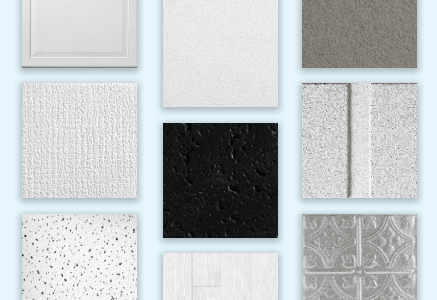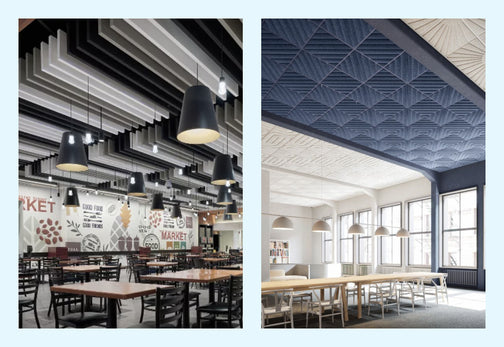General FAQs
What are Armstrong ceilings made of?
Mineral fiber ceilings are between 24% to 95% recycled materials and contain renewable/natural materials like mineral wool, starch, perlite (a form of natural glass), and clay. Other types of ceilings are made of fiberglass, MDF or wood veneers, and PVC plastic. See individual product pages for more information.
Will the ceiling sag over time?
If properly installed under the right conditions (no excessive humidity), standard ceilings are highly resistant to sagging. We recommend superior sag/mold/mildew resistant panels, or fiberglass panels, for places with high or seasonal humidity but not where there’s continuous moisture (shower rooms, swimming pool areas, etc.).
Do Armstrong ceilings protect against the spread of fire?
Our mineral fiber and fiberglass panels are inherently non-combustible and have been tested to meet stringent fire performance standards. Most Armstrong® ceiling panels carry a Class A rating under ASTM E84, indicating excellent flame spread and smoke development performance. Other ceiling products may carry a different rating. See individual product pages for specific fire ratings for each.
Note: Insulation must never be placed behind fire-rated ceilings, unless designated in a UL design assembly, and without prior approval from your building code official.
If my ceiling question is not listed here, how can I get an answer?
Can your tiles be installed in humid or wet locations?
Definitely. Look for suitable products on the site marked with a superior level of "Sag/Humidity Resistance.” These tiles are designed to stand up to humid spaces without sagging or developing mold.
Will your ceiling tiles improve my acoustics?
Yes, Armstrong® ceiling tiles are specifically engineered to enhance acoustical performance in a wide range of environments. Whether you're aiming to reduce noise, improve speech intelligibility, or create a more comfortable soundscape, we offer solutions tailored to your needs. See individual product pages for acoustical performance values.
Check out our Acoustics page for an in-depth explanation and exploration.
Ceiling Maintenance
How can I replace a damaged tile?
Our Identify My Ceiling tool can help you ID it and suggest replacements.
How do I clean my mineral fiber, fiberglass or other type of ceiling?
Cleaning guidelines are different for individual products. Reference our guide for specific recommendations.
Check out our guide to cleaning commercial ceiling tiles here.
Check out our guide to cleaning residential ceiling tiles here.
Ceiling Installation
Can I install an Armstrong ceiling as a Do-It-Yourself project?
Yes! Drop ceiling installation is a task for experienced do-it-yourselfers. Direct-apply options are a little easier.
Do I need to install insulation between floors?
Most ceilings are installed between floors that are maintained at the same temperature – making insulation unnecessary. Most basements are at least partly heated by heat flow through the ceiling from the heated space above. In that case, attempting to insulate the basement ceiling surface could actually reduce heat flow.
Can I put insulation on the back of an Armstrong ceiling?
Yes, but ONLY on Armstrong suspended ceiling panels that are at least 5/8" thick and using rolled insulation. Install it perpendicular to the cross tees so that the weight is on the suspended grid system and there’s air space between the insulation and the panel. Ask your dealer for specific details/instructions.
NOTE: Insulation must never be put behind fire-rated ceilings unless designated in a UL design assembly. Backloading fiberglass panels is not recommended, and insulation should not be allowed to touch the backs of WOODHAVEN planks.
What is the minimum overhead distance required for a new suspended ceiling?
A minimum of three inches of overhead clearance is required between the existing ceiling and the new suspended ceiling grid. This space allows for proper installation of the grid system and ceiling panels. Additional height might be necessary if installing recessed lighting.
Should ceiling materials adjust to room conditions (temperature and humidity) before installation?
Yes. Unpack ceiling materials at least 24 hours before installation to get them acclimatized. Do NOT install if the room is excessively humid. WOODHAVEN planks may take longer to acclimatize due to their natural MDF material. See specific product instructions for best results.
Can ceilings be installed over embedded radiant-heat coil ceilings?
No. Never install ceiling panels below an existing ceiling that contains embedded radiant-heat coils. An appreciable loss of heating efficiency will result and the ceiling will not remain stable.
How do I choose the right ceiling tile for my installation?
Our Ceiling Selector can help you figure out what you need. After answering a few quick questions, we’ll give you recommendations and can also help you with your order and installation.
How do I cut and trim my tiles for use along ceiling borders?
Please refer to our step-by-step instructions in our How-To Guide by clicking here.
Payments and Deliveries
What are my payment options?
Can I claim tax exempt status on my order?
- • When logged in, click on the ‘click here to submit certificates‘ button.
- • The platform will guide you through the process until completion.
- • Once you submit, you will be able to immediately proceed with your purchase(s) exempt from sales tax.
If you have any questions, please connect with our customer support team.
Is there a minimum order requirement?
How do I track my deliveries?
Ceiling Lighting
Can existing light fixtures be used with a new ceiling?
Yes, but you might have to remove the fixture to do the installation and then reinstall it over the new ceiling. Always consult installation guidelines and local building codes to ensure a safe and proper setup.
How many fluorescent lighting fixtures will I need for a new ceiling if they serve as my main source of light for my room?
The rule of thumb for 4’ fluorescent tube light fixtures is two for every 75 square feet of suspended ceiling.
Can a hanging or swag lamp be used with an Armstrong ceiling?
Yes. For drop ceilings, it must be independently supported – it cannot rely solely on the ceiling grid or tiles. We recommend using hanger wires attached to the structural ceiling above to fully support the weight of the fixture. For heavier hanging lights, additional support wires or even direct mounting to ceiling joists may be necessary. Always follow both the fixture manufacturer’s guidelines and Armstrong installation instructions to ensure safety and code compliance.
How do I install recessed lighting?
Please refer to our step-by-step instructions in our How-To Guide by clicking here.
Ceiling Painting
Can Armstrong ceilings be painted?
All tiles and panels (except fiberglass) can be painted with latex paints. The front and back of 24-in x 24-in and 24-in x 48-in panels should both be painted.
It is important to note that we can’t guarantee the surface-burning characteristics, fire-resistance ratings, acoustical performance, dimensional stability/sag, or light reflectance will stay the same after repainting. For this reason, field painting will void the warranty.
Will painting acoustical ceilings affect acoustic efficiency?
Most acoustic ceiling tiles are designed to absorb sound through their porous surfaces and perforations. When you apply paint—especially thick or glossy coatings—it can clog these pores and holes, reducing the tile’s ability to absorb sound effectively. To minimize loss of acoustical efficiency, use a nonbridging paint which does not cover the holes.
Can I paint the ceiling grid?
Grid can be painted any color or to mimic any metal – bronze, tin, gold, or copper.
For application, we recommend a small pure china bristle for a smooth finish. Use a trim roller for large areas or spray paint. Contact your local paint store to have them color match a grid sample for the best match.
Indoor Air Quality
Are Armstrong ceilings safe to install and use?
Yes. Studies show that exposure during conventional installation are below the standards for nuisance and substances like dust. Power tools should be equipped with special dust collection devices and workers should wear the appropriate NIOSH-designated respirators. Once installed, our ceiling products do not represent an identifiable health risk.
Do Armstrong ceiling products contain mineral wool? If so, do these products represent a health risk?
Some contain mineral wool, but they do not represent a health risk. Studies submitted to the United States Department of Labor, Occupational Safety & Health Administration ("OSHA") showed that exposure to mineral wool during a typical installation is significantly below the permissible exposure limit (PEL) of one fiber per cubic centimeter. Once installed, our ceiling products do not represent an identifiable health risk.
Do Armstrong ceiling products contain silica? If so, do these products represent a health risk?
Most Armstrong mineral wool ceilings contain silica, but they do not represent a health risk. The only foreseeable installation practice that may generate measurable levels of respirable silica problem is through the use of power tools. For this reason, we recommend the use of a dust respirator and a dust collection device during power tool applications. Once installed, our ceiling products do not represent an identifiable health risk.
Do Armstrong ceiling products release formaldehyde? If so, do they represent a health hazard?
Certain materials used in the production of our ceiling products might release small amounts of formaldehyde during installation, but most of it is driven off during manufacturing. With proper ventilation, any residual formaldehyde released during installation dissipates quickly and is well below permissible exposure levels established by the United States Department of Labor, Occupational Safety & Health Administration (OSHA). Once installed, our ceiling products do not represent an identifiable health risk.
Some of our ceiling products are available with AIRGUARD coating, which actively removes formaldehyde from indoor air once installed. See individual product pages for more information.
Do Armstrong fiberglass ceiling products represent a health hazard?
The safety of our fiberglass ceiling products has been confirmed through occupational studies of fiberglass workers over the last 50 years. Study results and independent researcher reviews give no indication that exposure causes a health risk. But if power tools are used during installation, they should be equipped with special dust collection devices and workers should wear NIOSH-designated respirators. There might be skin irritation during installation but the condition is temporary and disappears when there is no physical contact. Once installed, our ceiling products do not represent an identifiable health risk.
Has there been a recent favorable change in the ruling regarding the health aspects and classification of fibrous glass, mineral and slag wool?
Yes. In October 2001, the International Agency for Research on Cancer (IARC) re-evaluated the 1988 IARC assessment of fibrous glass, rock, and slag wool fibers and downgraded them from Group 2B (possible carcinogen) to Group 3 (not classified as to carcinogenicity in humans). All Armstrong ceiling products that use these fibers fall under Group 3.
Are respirable fibers released during general maintenance activities that would require the disturbance/removal of the OPTIMA High-NRC product?
Tests were done to measure respirable fibers generated after the installation, removal, and reinstallation of Hi-LR OPTIMA fiberglass product. Every time, the results of monitoring* one hour, and 24 hours, after each activity did not detect the presence of respirable fibers.
*Large chamber protocol followed the guidelines of ASTM Standard D5116. The dynamic chamber was operated at one air change per hour and 23×C and 50% relative humidity. Fiber counts were conducted in accordance with NIOSH Method 7400B.
Are respirable fibers released during general maintenance activities that would require the disturbance/removal of the CIRRUS product?
Tests were done to measure respirable fibers generated after the installation, removal/reinstallation of CIRRUS mineral fiber product. Every time, the results of monitoring* one hour, and 24 hours, after each activity did not detect the presence of respirable fibers.
*Large chamber protocol followed the guidelines of ASTM Standard D5116. The dynamic chamber was operated at one air change per hour and 23×C and 50% relative humidity. Fiber counts were conducted in accordance with NIOSH Method 7400B.
Returns
How long do I have to return an item?
Which items are eligible for return?
All items are eligible for return, except for the *special order items listed below. Please note that some items will require additional return fees due to weight, size, location, and/or other shipping factors. Eligible returns are subject to a twenty percent (20%) restocking fee plus the cost of shipping.
*Non-returnable special order items include TECTUM Create! Ceiling Panels & Walls, TECTUM Design Art Lines - Direct Attach, TECTUM Design Art Lines - Tegular, TECTUM DesignArt Shapes - Direct-Attach Ceilings & Walls, SOUNDSCAPES Shapes, SOUNDSCAPES Blades, SOUNDSOAK PANELS, EASY ELEGANCE Shallow Coffer, EASY ELEGANCE Deep Coffer, FELTWORKS Acoustical Ceiling Panels, and FELTWORKS Blades - VARAFFIX Reinforced Rectangular. Start your return process by filling out this form



 Thanks for subscribing!
Thanks for subscribing!